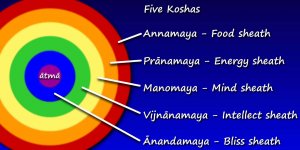| TV Channels / Documentaries |
The Inner Journey: A Course in Meditation
Part 5: Being in the Present Moment
A video presentation by Swami Tadatmananda Saraswati, Arsha Bodha Center, United States
(Tapescript) When you first begin learning to meditate, you're likely to discover that your mind is incredibly susceptible to all kinds of distractions.
Before you even realize it, your thoughts can wander away from the technique you're practicing and get immersed in mundane matters, ranging from trivial things like your plans for dinner tonight, to much more serious concerns about your family, health issues or financial troubles.
Your thoughts usually get dragged in one of two directions - into the past or into the future.
For example, if a friend recently said something really hurtful to you, while you're meditating, memories of the conversation can flood your mind and draw you back to that painful experience. And just like memories can draw your mind back to the past, worries can draw your mind into the future.
If you're waiting to receive the results of a recent biopsy, when you meditate, your mind can easily get caught up in thinking about what the future holds for you.
Metaphorically, your mind is like a vast forest of thoughts in which you can easily lose your way and wander about aimlessly. In that forest of thoughts, memories and worries are like thieves hiding in the shadows. At any moment, they can grab hold of your attention and hijack your entire meditation session.
Yet, painful memories and nagging worries are a normal part of life. You can't completely avoid them. So then, how can you resist their power to drag your mind into the past or future when you're trying to meditate?
Well, one solution is to firmly fix your attention on the present moment, on what's happening right now.
In the present moment, there's no past or future; there's only the experience of here and now. By fixing your attention on the present moment, you can temporarily break free from the grip of past pain and future worries.
One way to keep your mind in the present is simply to observe something that's continually changing, some kind of activity. For example, when you watch little children playing in the park, or puffy clouds floating across the sky, or a waterfall tumbling down a mountainside you probably find that watching such things is pleasant and relaxing.
Why? Because when your attention is fixed on these things, things that are constantly changing, your mind remains focused on the present moment. In this way, your mind is freed from painful memories and worries about the future, at least for a little while.
One of the most widely used meditation techniques uses this same principle.
The technique is simply to observe your breathing, the constantly changing, rhythmic movement of your breath. About twelve times a minute, you complete a full cycle of filling your lungs with air and then releasing it. This natural flow of inhalation and exhalation is an ideal focal point for meditation.
By observing the movement your breath, you can fix your attention on the present moment and restrain it from wandering into the past or future. Eventually, you can train your mind to remain firmly established in the present whenever you meditate.
In many practices, you have to concentrate your attention on a suitable object of meditation, like a mantra, or a sacred image, or the sound of a bell.
Your own breath can also be used as an object of meditation. The simplest technique for meditating on your breath is called prana vikshana, literally, observing the breath. The primary meaning of the word prana is actually life-force. The air you breathe fills your body with life and sustains its activities.
In the practice of prana vikshana, you observe the rhythmic flow of life-giving air as it enters your body with each inhalation and flows out with each exhalation.
Prana vikshana is different from pranayama, the breath control exercises prescribed by Patanjali in the fourth limb or anga of yoga. We'll learn several pranayama techniques in future lessons.
But here, in the practice of prana viskshana, you don't have to control or regulate your breathing in any way whatsoever. You simply observe your breath, passively.
This particular practice is tremendously useful. For beginners, it's a powerful means for training your mind to remain in the present moment. For advanced practitioners, it's often used in combination with other techniques, as we'll see later.
Now it's time to perform a guided meditation exercise using prana viskhana.
As we discussed before, it's best if you sit in a place that's particularly suitable for meditation. You can listen to this exercise using a laptop, tablet, or mobile device like your phone. This exercise is also available as a podcast or download from our website using the links in the video description below.
I hope you are now seated comfortably in a suitable place.
This exercise will take about 15 minutes. First, sit with a proper posture as we discussed before, close your eyes gently, and take a deep breath to get settled down.
Now, affirm your intention and commitment to meditate with this sankalpa:
I know that I have many unfulfilled responsibilities and issues that really need to be addressed. But I don't want to be distracted by those things during this meditation.
So right now, I give myself permission to set all those concerns aside, just for the next 15 minutes.
Next, we'll perform the progressive relaxation exercise, like in the previous lesson.
Start by turning your attention to your feet. Become aware of any sensations there.
Notice the sense of pressure as your feet press down. Notice the touch of your clothing and feelings of warmth or coolness. Now, become aware of any tension that might be held in the muscles of your feet. And let go of that tension. Allow those muscles to relax completely.
Next, turn your attention to your ankles and calves.
Notice sensations of pressure, the touch of your clothing, warmth or coolness.
Become aware of any tension held in the muscles of your ankles and calves, and let go of that tension completely. Next, turn to your knees and thighs.
Notice the weight of your hands or arms where they rest. Notice any other sensations.
Become aware of any tension held in your knees and thighs, and let go of that tension completely.
Next, turn to the trunk of your body. Feel the weight of your body pressing down.
Feel the firmness of the seat beneath you. Let go of any tension.
Next, turn to your lower back and stomach, together. Become aware of sensations. Let go of any tension.
Now turn to your upper back and chest. Become aware of sensations, and let go of any tension.
Now, your shoulders, arms, and hands. Become aware of sensations and let go of any tension.
Finally, your neck, face, the muscles around your eyes, at your temples, and across your forehead. Let go of any tension.
Now, we're ready to begin the practice of prana vikshana. Turn your attention to your breath.
Observe your inhalation and exhalation by mentally tracing the passage of air with each breath. As you inhale, observe the air entering your nostrils, traveling down your windpipe, and filling your lungs.
As you exhale, observe the air flowing out of your lungs, rising up your windpipe, and leaving your nostrils. Breathe normally, naturally, effortlessly.
Continue to observe the air entering your nostrils, traveling down your windpipe, and filling your lungs.
Then observe the air flowing out of your lungs, rising up your windpipe, leaving your nostrils and returning to the room.
Continue to observe your breath, mentally tracing the passage of air with each inhalation and each exhalation. Breathe normally, naturally, effortlessly.
Continue to observe your breath, mentally tracing the passage of air.
You might notice that your attention starts to wander after a while. If that happens, here's a method you can use to keep your mind from wandering so much. This method involves mental counting.
With each inhalation, count silently 1.... 2.... 3.... as you trace the passage of air entering your nostrils, traveling down your windpipe, and filling your lungs.
Then with each exhalation, count silently 4.... 5.... 6.... as you trace the passage of air flowing out of your lungs, rising up your windpipe, and leaving your nostrils.
Don't change the speed of your breathing. Breathe normally.
Adjust the counting to match the length of each breath.
Inhaling, count 1 . 2 . 3 . as you trace the passage of air, entering your nostrils, traveling down your windpipe, and filling your lungs.
As you exhale, count 4 5. 6 . as you observe the air flowing out of your lungs, rising up your windpipe, and leaving your nostrils.
Inhaling, count 1 . 2 . 3 . as you trace the passage of air.
Exhaling, count 4 5. 6 . as you trace the passage of air.
Inhaling 1 . 2 . 3 . tracing the passage of air.
Exhaling 4 5. 6 . tracing the passage of air.
We'll continue for just two more minutes.
Inhaling 1 . 2 . 3 . tracing the passage of air.
Exhaling 4 5. 6 . tracing the passage of air.
Now, as we come to the end of this guided meditation, you can stop counting, stop observing your breath, and just listen to these closing remarks.
If you like this prana vikshana technique, you might consider practicing it again tomorrow, with or without listening to me. If you practice it independently, you can change it in any way that makes it more effective for you.
If your attention wanders away from your breath frequently, be sure to use the mental counting method. And every time your attention wanders, simply bring it back to your breath and continue counting.
On the other hand, if your attention mostly remains fixed on your breathing, then it's not necessary to use the counting method.
In the next lesson, we'll discuss how to develop a regular, daily practice of meditation.

Subscribe now to get unrestricted access to all resources, in all languages, throughout this web site!
Subscription Form
YOU MAY ALSO LIKE


Subscribe now to get unrestricted access to all resources, in all languages, throughout this web site!
Subscription Form

